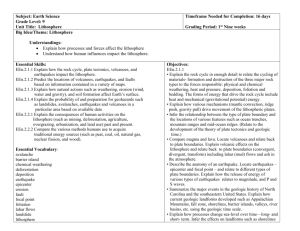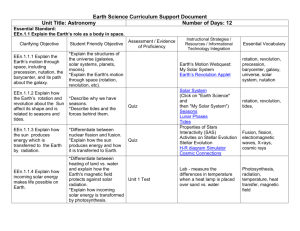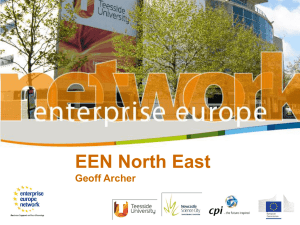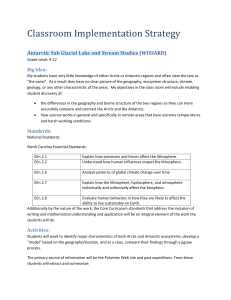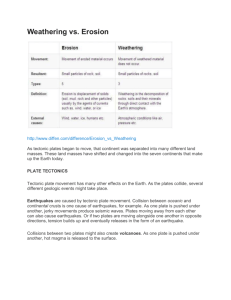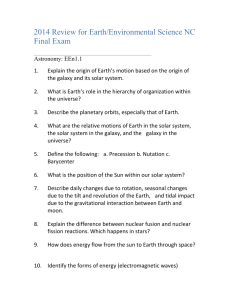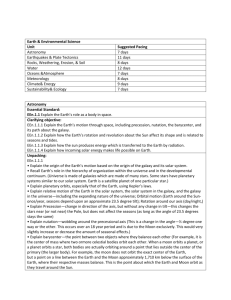Key Concepts
advertisement
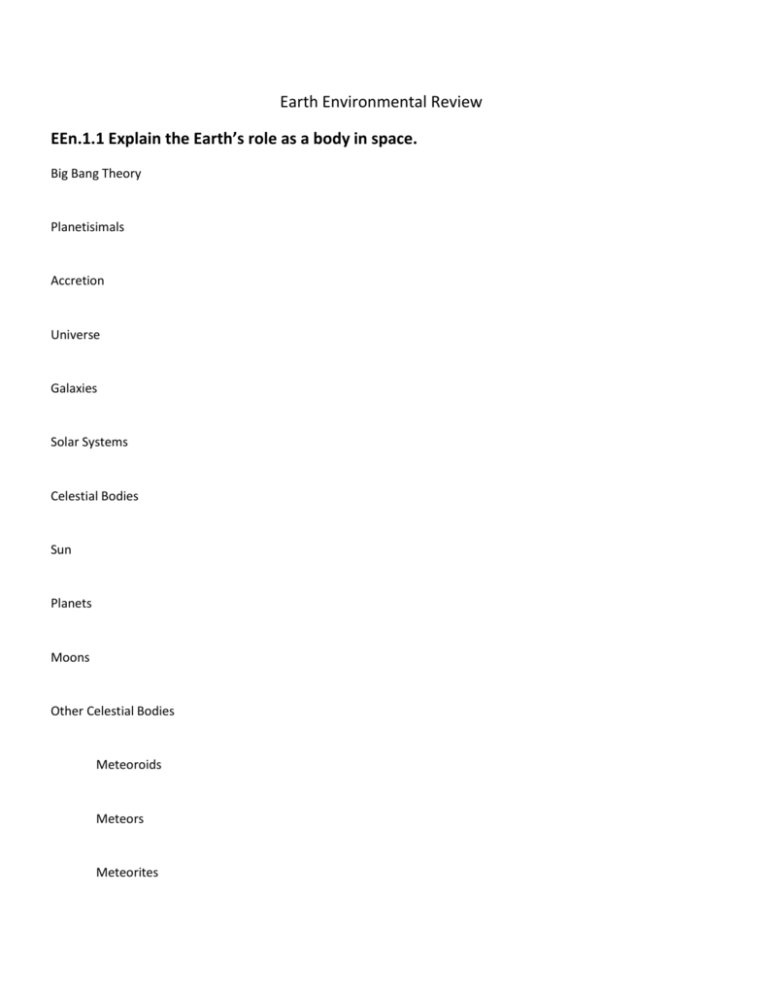
Earth Environmental Review EEn.1.1 Explain the Earth’s role as a body in space. Big Bang Theory Planetisimals Accretion Universe Galaxies Solar Systems Celestial Bodies Sun Planets Moons Other Celestial Bodies Meteoroids Meteors Meteorites Comets Asteroids Explain the Earth’s motion through space Kepler’s Laws 1. 2. 3. Precession Nutation The barycenter Gravity Earth’s path about the galaxy. Earth’s axial tilt / other planets Earth’s rotation on it’s axis Earth’s revolution about the Sun Affect its shape Motions related to seasons and tides. Describe daily changes due to rotation Seasonal changes due to the tilt and revolution of the Earth Tidal impact due to the gravitational interaction between the Earth and moon and sun Develop a cause and effect model for the shape of the Earth explaining why the circumference around the equator is larger than that around the poles. Fusion Fission Radiation Radiant energy of stars Light / electromagnetic waves produced by the sun / stars How bad rays / waves / light are filtered by the atmosphere (Ultra Violet, X-rays, cosmic rays, etc.) Summarize how energy flows from the sun to the Earth through space. Explain how the tilt of the Earth’s axis results in seasons due to the amount of solar energy impacting the Earth’s surface. Explain differential heating of the earth’s surface (water temperature vs. land temperature) Explain how solar energy is transformed into chemical energy through photosynthesis. Explain how the earth’s magnetic field protects the planet from the harmful effects of radiation Heliocentric Geocentric Dose the sun move? As it’s self within the solar system… Nutation? Tugging? As a system… Big Bang? Hertzprung Russel l (H-R) Diagram Evolution of a star EEn.2.1 Explain how processes and forces affect the lithosphere. Explain the rock cycle in enough detail to relate the cycling of materials Formation and destruction of the three major rock types to the forces responsible Physical weathering Chemical weathering Heat and pressure Erosion Deposition Foliation Bedding The forms of energy that drives the rock cycle include heat and mechanical and gravitational potential energy Explain how various mechanisms drive movement of the lithospheric plates mantle convection ridge push Infer the relationship between the type of plate boundary and the locations of various features such as ocean trenches, mountain ranges and mid-ocean ridges Relate to the development of the theory of plate tectonics and geologic time Compare magma and lava Locate volcanoes and relate back to plate boundaries Explain volcanic effects on the lithosphere and relate back to plate boundaries (convergent, divergent, transform) including lahar (mud) flows and ash in the atmosphere Describe the anatomy of an earthquake Locate earthquakes – epicenter and focal point – and relate to different types of plate boundaries Explain how the release of energy of various types of earthquakes relates to magnitude, and P and S waves Summarize the major events in the geologic history of North Carolina and the southeastern United States Explain how current geologic landforms developed such as Appalachian Mountains, fall zone, shorelines, barrier islands, valleys, river basins, etc. using the geologic time scale Explain how processes change sea-level over time—long- and short-term. Infer the effects on landforms such as shorelines and barrier islands Infer the locations of volcanoes, earthquakes and faults from soil, geologic and topographic map studies. (Relate fault locations/types to plate boundaries.) strike-slip reverse normal Plate Boundaries and how they combine Convergent Divergent Transform Oceanic Continental Make predictions based on data gathered over time in conjunction with various maps. Soil is the result of weathering of rocks and includes weathered particles: sand, silt and clay. Humus Soil Profile / Rock Layers Stable Rock Explain differences in chemical and physical weathering How weathering rates are affected by a variety of factors including climate, topography and rock composition Compare erosion by water, wind, ice, and gravity and the effect on various landforms Conclude the best location for various types of development to reduce impacts by geohazards and protect property Explain precautions that can be made to protect life from various geohazards and include meteorological hazards Some examples include landslides, earthquakes, tsunamis, sinkholes, groundwater pollution, and flooding EEn.2.2 Understand how human influences impact the lithosphere Explain the need for and consequences of various types of land Urbanization Deforestation Agriculture Mining Aquaculture Explain ways to mitigate(solutions) detrimental ( harmful or adverse) human impacts on the lithosphere and maximize sustainable use of natural resources Explain the effects of human activity on shorelines Explain the effects of human activity on mountainsides Development and artificial (man-made) stabilization efforts for Shorelines Mountains Explain the effects, especially in development and artificial stabilization efforts Compare the methods of obtaining traditional energy resources: harvesting (peat and wood) mining (coal and uranium/plutonium) drilling (oil and natural gas) What are effects of these activities on the environment? What are ways to mitigate the adverse effects of these activities on the environment? EEn.2.3 Structure and processes within the hydrosphere Explain how water is an energy agent Currents Heat transfer Specific heat Sea Breeze Land Breezes How the density of ocean water is affected by temperature How this results in major ocean currents distributing heat away from the equator toward the poles. Explain how coastal climates are moderated by water (due to its high specific heat capacity) in comparison to inland climates. Explain how ground water and surface and atmospheric water interact. Seven stages of the water cycle, where they are, what they do. Surface Water Evaporation Evapotranspiration Condensation Condensation Nuclei Precipitation Surface Runoff Infiltration Groundwater (and back again) Water table Salt water intrusion Wet cycle Dry Cycle Explain river systems including NC river basins Aquifers Watersheds Bedrock Explain how flood events might be affected by groundwater levels. Ebb and Flood EEn. 2.4 How humans use water. Evaluate human influences on freshwater availability. Evaluate human influences on water quality in North Carolina’s river basins, wetlands tidal environments estuaries EEn. 2.5 Atmosphere and Weather… Whether you want it or not, everyone relys on the weather. What is the most important tool? Atmospheric Layers Atmospheric properties Analyze atmospheric graphs and charts, different types Radiant energy Air masses types Movement Pressure Fronts Cloud formation Cloud types Cloud prediction Wind Wind patterns What affects air density? Weather instruments Weather technology Weather maps Barometric pressure… falling, steady, rising, Barometric maps Isobars Temperature Thermobars Contour lines Dewpoint Wind chill/feel likes Precipitation Water vapor and clouds Acid rain formation pH of rain Human activities impact the atmosphere Aerosols Chlorofluorocarbons Burning hydrocarbons Industrial byproducts Over farming Development / microclimates/ heat islands Mitigation/Solutions Severe/ Extreme weather precautions, predictions, preparedness to preserve property and people(life). Personal obsevations? EEn. 2.6 Global Climate Change… We want the Earth to be warm??? Keep in mind that climates change over time… back and forth, comes and goes, ebb n flood. Weather vs. climate Climate vs. weather Global warming Köppen Climate Classification Polar Temperate Tropical Marine Continental Arctic – so cold, no precipitation El Nino La Nina Volcanic disruptions Sunspots Radiant energy Ultra Violet Light – U.V. Earth’s orbit shifts Earth’s axial shifts Carbon dioxide fluctuations and shifts Greenhouse gases Greenhouse effect Why are humans concerned with CO2 ,carbon dioxide Analyze patterns of changes - maps Climate changes due to natural causes Climate changes due to human activities Burning hydrocarbons – fossil fuels Ozone Deforestation Temperature changes and fluctuations Ocean pH change due to climate/impacts Sea level Changes due to climate/impacts Deforestation increased industrialization Burning fossil fuels increased industrialization Development Micro-climate Heat island Human impacts Effects on agriculture, ocean life Ecosystem balance Glacial periods Glaciations Solutions Why are agricultural areas losing rain? EEn. 2.7 Sustainability… For who??? Keep in mind, “Not in my Back Yard” mentality and humans cause most of the problems. Biosphere Biome Plants and animals that make up the different biomes Biotic vs. Abiotic Biodiversity Human impact on the biosphere Pollution Point source pollution Non-point pollution Ecological Footprint Ecological Carrying Capacity Sustainability Stewardship Match Land Forms to Biomes Variations of populations Ecosystem Nonnative Species Invasive species Human impact on the environment Solutions EEn. 2.8 Sustainability and Resources Alternative Energies (Focus on N.C.) Solar Wind Geo thermal Wave action Nuclear Biofuels Must nose… Metric System Phase changes / States of matter Scientific method Science and Lab Safety Lab Equipment Cycles Photosynthesis
